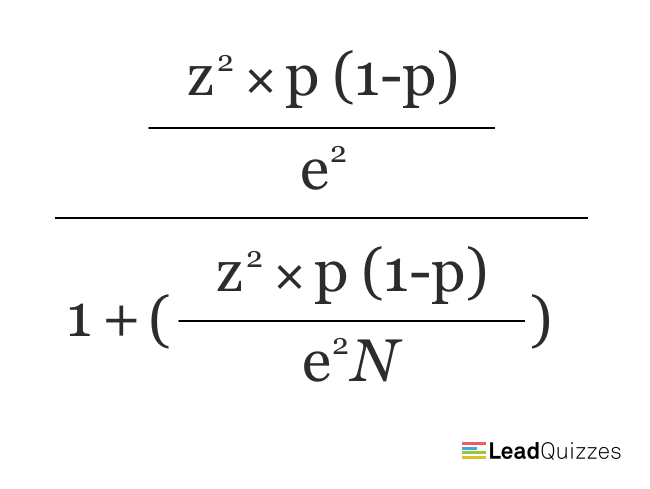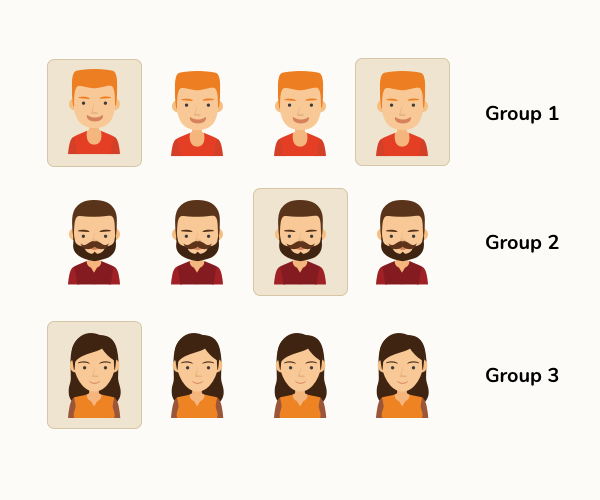With dozens of online tools, creating a survey, distributing it and analyzing the results has never been easier for marketers. However, before you put these tools to work, you want to make sure the results will reflect the actual opinions and attitudes of your target market.
Determining the right sample size and method of sampling is a prerequisite to reliable survey results. In this article, we will show you how to do that easily using our sample size calculator.
Sample size calculator
Calculate your sample size
When you calculate an ideal sample size, you deal with three numbers: population size, confidence level, and margin of error.
1. Population size
Population size is the total number of people in the group you are researching. For example, if you are studying people in San Francisco, the population size is 884,363.
If you are surveying teenagers in the United States, you are looking at roughly 42 million people. You can find this information on the official statistics pages, such as the U.S. Census Bureau.
2. Confidence level
Confidence level refers to the percentage of different samples that would repeat the result of your survey. For example, let’s imagine you created 10 separate samples and gave them the same survey. If 9 out of 10 times you get the same result, you have a 90% confidence level. The usual confidence level in research is 95%.
3. Margin of error
Margin of error shows how much the responses of the real population could differ from your survey results. For example, if your survey results show that 65% of Americans eat sweets on a daily basis, a 2% margin of error means that the actual percentage of those people falls somewhere between 63% and 67%. This bracket represents a confidence interval.
If you are not *too* hung-up on the surgical accuracy of the results, sometimes you can allow your survey to have a larger margin of error.
The sample size calculator we’ve shown you is based on this formula.

If you want to calculate the sample size on your own, you will do it using the following values.
- z – z score is directly tied to the confidence level, and based on confidence level, its values can be:

- e – margin of error
- n – population size
- p – 0.5
How important is the sample size?
The importance of adequate sample size depends on the purpose of your survey.
If you are conducting a customer satisfaction survey, it is clear that your “population size” is limited. Actually, if you try to use the sample size calculator in these cases, your sample size can even turn out to be bigger than the entire number of your active customers and clients.
While customer satisfaction surveys should be as accurate as possible, their primary purpose is getting feedback that gives you a broad idea about their customer experience.
On the other hand, when you are studying a market in search of opportunities and target customers, you will definitely want to reach as many people as possible and gather a statistically significant sample.
On top of that, you will have to select this sample using scientific methods – but don’t let this scare you. It is actually quite simple!
Types of sampling
The greatest challenge of sampling is avoiding both negative and positive bias from respondents. This is why it is recommended that you avoid some types of sampling – we will talk about the reasons in the following section.
Sampling methods are grouped into two large categories with subcategories:
1. Probability (random) Sampling
Probability sampling relies on random selection of respondents to give each member of the target group an equal chance to be part of the sample. There are several types of probability sampling.
a) Simple random sampling
Every member of the group has an equal chance of selection. This type of sampling is recommended to marketers who are still exploring market opportunities and possible target markets within the industry.

b) Stratified sampling
Members of the group are divided into small subgroups. Respondents from these subgroups are selected randomly and proportionally to members from other subgroups.
For example, you are researching women in the United States, and you divide them into subgroups based on their age, religion, race, education, or income.
This type of sampling is recommended to the marketers who have a broad idea about their target market and basic information about this population.

c) Cluster sampling
The entire population is divided into clusters (based on age, sex, location, income, etc.), and clusters are randomly selected. In single-stage cluster sampling, all the members of the selected clusters become part of the sample. In two-stage cluster sampling, respondents are further randomly picked from the selected clusters.

For example, if you want to research the young population’s attitudes towards green energy, you can divide the entire population of the United States into state-based clusters – let’s imagine you randomly select Texas, Massachusetts, and Michigan. You can either survey all young people in these states or randomly select a sample from these clusters.

d) Systematic random sampling
The entire population is put on a list. From the list, the first member is randomly selected, and then every next member of the sample is chosen at regular intervals of the population. Put simply, you could go through the list and select one in three elements on it.

2. Non- Probability Sampling
With non-probability sampling, the focus is not on selecting random sample or making sure the sample accurately reflects the entire population. With this method, some respondents have a higher chance of becoming part of the sample. These are the types of non-probability sampling:
a) Convenience sampling
The respondents are selected based on their availability. The easier the elements of the group to reach, the higher the chance they will be part of the sample. For example, you put up a survey on a website and collect sample from visitors who were willing to answer the questions.
This type of sampling is common for customer satisfaction surveys. Even though they do not accurately reflect the attitudes of all your customers, they are still useful since these surveys are exploratory in nature and the quality of feedback is their greatest value.
b) Purposive sampling
Using this method, you select a sample of people who fit the goal of your study. For example, if you want to research a niche market, the qualifying criteria for sample selection would be whether a person is a buyer of products in this niche.
c) Quota sampling
Quota sampling relies on a set standard that is intended to make the sample mimic the structure of the population it belongs to. For example, if the target group has 48% of women and 52% of men, the sample will be constructed to reflect that proportion.
d) Referral/snowball sampling
This method is used for research in very specific, often confidential areas where the size of an adequate sample is fairly low. For example, if you want to research the population that suffers from rare health conditions, your sample will be fairly small and hard to obtain. The potential respondents are usually found through the system of referrals, slowly contributing to the sample.

Which type of sampling should I use?
Don’t be biased – each of these methods exists for a reason and has its own value. Which type of sampling you are going to use depends on the stage and goal of your market research.
In general, non-probability sampling is a great time and cost-effective way to kickstart your market research and gather some basic information about your potential customers. This type of survey sampling is also a great way to conduct qualitative research, such as getting feedback from your existing customers or leads.
On the other hand, you should use probability sampling when you conduct surveys that will accurately and quantifiably reflect the attitudes of your target market. This type of sampling is important when research results are used as a source of guidance in product development and marketing strategy.
Conclusion
Now that we got you settled on the sample size and the method of sampling you could use in your survey, let’s look deeper into the types of surveys you can create.
Want to put this knowledge into action with a simple survey builder? With LeadQuizzes survey builder, you can easily make questionnaires and surveys that will help you learn more about your customers and attract new ones. You can run this survey or questionnaire as an ad, embed it on your website, or send it to your email list.